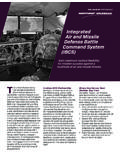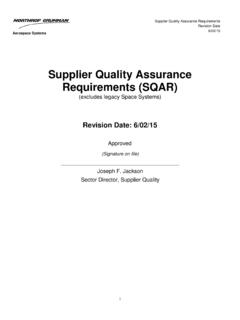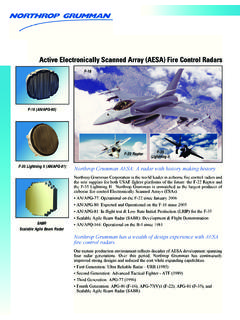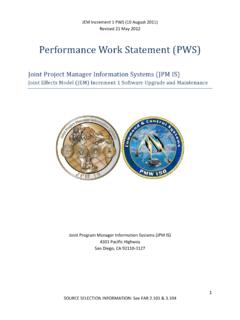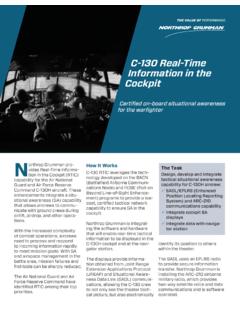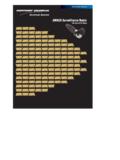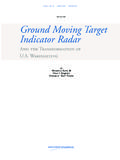Transcription of Northrop Grumman Cutting Edge Optronics …
1 Northrop Grumman Cutting Edge Optronics technical Note #17 kW Class, Wavelength Stabilized Laser Diode Arrays Numerous laser media exist with absorption peaks that are too narrow to make use of standard laser diode pump arrays with emission widths of 2-3 nm. For these absorption peaks (such as Nd:YAG at 885nm, Nd:YVO4 at 880nm, and Yb:YAG at 969nm), laser diode pump arrays with narrower emission spectra are highly beneficial. Northrop Grumman Cutting Edge Optronics has developed a process for building high-power laser diode arrays with narrow emission spectra by adding Volume Bragg Gratings during the packaging process.
2 These arrays emit with a spectral width of approximately (FWHM), and are available with output powers ranging from tens of watts to several kilowatts. Experimental data is presented in this technical note for arrays operating at up to 100W per bar (CW). 2011 Northrop Grumman Systems Corporation All Rights Reserved 050100150200250300880882884886888890 Intensity (arb. Units)Wavelength (nm)After VBGB efore VBG Wavelength-Stabilized, High-Power Laser Diode Arrays Ryan Feeler1, Joseph Levy, and Jeremy Junghans Northrop Grumman Cutting Edge Optronics , 20 Point West Blvd., St. Charles, MO USA 63301 1.
3 INTRODUCTION A variety of applications exist for laser diode arrays with narrow wavelength spectra. The width of the wavelength spectrum of a typical high-powered laser diode bar is on the order of 1-2nm (FWHM), depending on the bar design and the operating parameters. When a significant number of laser diode bars are joined together to form an array, the differences in center wavelength of the individual bars combine with the typical intrinsic spread of each bar to produce arrays with wavelength spread of 2-3nm. While this is sufficient for a number of applications (pumping of some solid-state laser crystals, materials processing, etc.)
4 , it is completely insufficient for others. The use of external wavelength locking elements has become a popular approach for producing laser diode arrays with narrow wavelength spectra (< 1 nm). This technology utilizes Volume Bragg Gratings (VBGs) as a means of providing feedback to the laser diode bar. This idea has been used extensively in the telecommunications industry for many years. It has also been used within the laser industry as a way to efficiently pump crystals or vapors that cannot be pumped by a diode array with a 2-3nm spectral width. 2. POTENTIAL USES There are many instances of laser media that could benefit from a diode laser pump source with a narrow wavelength spectrum.
5 One prominent example is shown in Figure 1, which shows the absorption spectrum of Nd:YAG over the wavelength range of 780-900nm. Perhaps the most common pump wavelength for Nd:YAG lasers is nominally 808nm. There is also a neighboring peak at approximately 805nm that creates an effective absorption width of and is ideally-suited for pumping by standard laser diode arrays. However, there are technical advantages associated with pumping at higher wavelengths. Most notably, the lower quantum defect associated with pumping at higher wavelengths results in a weaker thermal lens and lower depolarization losses.
6 As a result, pumping Nd:YAG at 869 or 885nm is an attractive alternative in many laser designs. Unfortunately the absorption peaks at these wavelengths are significantly narrower (~ 1nm and ~ 3nm, respectively), and therefore benefit from pump diodes with narrow emission spectra. Similar features are observed in other Nd-doped laser crystals, such as Nd:YLF and Nd:YVO4. Figure 1. Absorption curve for Nd:YAG. The approximate width of absorption peaks of interest is shown on the graph for reference. 1 (636) 916-4900, 024681012780800820840860880900 Absorption Coefficient (cm 1)Wavelength (nm)~ nm~ 1 nm~ 3 nm Another common laser crystal that benefits from pump arrays with narrow emission spectra is Yb:YAG.
7 The absorption curve of Yb:YAG is shown in Figure 2. There is a broad absorption peak centered around 940nm and a narrow peak located at 969nm. As is the case with Nd:YAG, certain laser designs benefit significantly from pumping at the higher absorption peak. In this case it is again advantageous to pump with a narrow linewidth diode array. Figure 2. Absorption curve of Yb:YAG. The approximate width of absorption peaks of interest are shown on the graph for reference. 3. technical APPROACH Northrop Grumman Cutting Edge Optronics (NGCEO) manufactures laser diode arrays in a wide variety of configurations with power levels ranging from 10 watts to a few kilowatts.
8 NGCEO has developed a process for producing high-power laser diode arrays with emission spectra on the order of nm by adding VBGs during the packaging process. NGCEO has included VBGs on some of its largest arrays, and has demonstrated these results in a production environment on arrays producing in excess of 3kW of continuous output power. These arrays feature microchannel-cooled packaging technology that allows high-powered laser diode bars (nominally 100W/bar) to be packaged in vertical stacks with bar-to-bar spacing (or pitch) of approximately mm. A basic schematic for this approach is shown in Figure 3.
9 First, a high-power laser diode bar is soldered to a microchannel-cooled heatsink. This assembly is pre-tested to validate proper operation and inspected to ensure proper bond and facet quality. A number of these assemblies (from n=1 to 56, depending on customer specifications) are then stacked into an array. Fast-axis collimating (FAC) lenses are then attached to each heatsink using an active alignment process. Lastly, a small VBG is individually aligned to each bar/lens assembly and attached to the frame of the array. Figure 3. Overview of approach used at NGCEO to produce wavelength-stabilized arrays.
10 Not to scale. When the device is operated, the light emitted from the laser diode bar is collimated by the lens and impinges upon the grating. The grating preferentially reflects light of a pre-selected wavelength back through the lens and into the optical 02468101214850 875 900 925 950 975 1000 1025 1050 Absorption coefficient (cm-1)Wavelength (nm)~ 16 nm~ 4 nmDiode BarHeatsinkFAC LensVBG cavity of the laser diode bar. This feedback method allows for light of a specific wavelength to be produced under a variety of operating parameters (temperature, current, etc.). NGCEO can produce wavelength-stabilized arrays in vertical stacks with up to 56 bars, or in horizontal or two-dimensional arrays of various sizes as determined by customer requirements.
